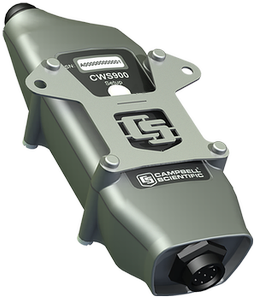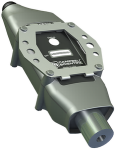This product is not available for new orders.

| Services Available | |
|---|---|
| Repair | No |
| Calibration | No |
| Free Support | Yes |
Überblick
Das CWS900E ermöglicht es, verschiedene Sensoren in ein kabelloses Sensornetzwerk einzubinden (siehe 'Kompatibel mit').
Es enthält ein internes 868 MHz- Funkmodem, das die Daten zur CWB100 Basisstation oder zu einem anderen kabellosen Sensor überträgt. Die Frequenz des Funkmodems wird in Europa als Standard verwendet.
Lesen Sie mehrFunktionen und Vorteile
- Ermöglicht es, verschiedene Sensoren kabellos einzusetzen
- Breitbandfunkmodem mit internen Frequenzsprüngen ermöglicht Übertragung über größere Strecken und mit weniger Inteferenzen
- Battery powered
- Eine zuverlässige, wartungsarme und stromsparende Methode zum Messen wo Sensorkabel unpraktisch sind oder aus anderem Grund unerwünscht
- Übertagungen können von bis zu 3 anderen kabellosen Sensoren weitergegeben werden
Bilder

Technische Beschreibung
The CWS900E has a sealed connector for attaching one rain gage, wind sensor, temperature/RH probe, or another low power sensor. It measures analog voltages, low level AC, pulse counts, and can supply an excitation voltage for powering some sensors or making bridge measurements. The type of measurement that the sensor performs is configured using Wireless Sensor Planner, Network Planner, or DevConfig software. The CWS900E interfaces with the PC for configuration via the A205 CWS Sensor to PC Interface.
The CWS900E can route its transmissions through up to three other wireless sensors. A datalogger is connected to the CWB100E base station for processing and storing the CWS900E's data.
The CWS900E is battery powered using either alkaline batteries or a rechargeable battery and a solar cell.
Why Wireless?
There are situations when it is desirable to make measurements in locations where the use of cabled sensors is problematic. Protecting cables by running them through conduit or burying them in trenches is time consuming, labor intensive, and sometimes not possible. Local fire codes may preclude the use of certain types of sensor cabling inside of buildings. In some applications measurements need to be made at distances where long cables decrease the quality of the measurement or are too expensive. There are also times when it is important to increase the number of measurements being made but the datalogger does not have enough available channels left for attaching additional sensor cables.
Kompatibel mit
Please note: The following shows notable compatibility information. It is not a comprehensive list of all compatible products.
Datenlogger
| Product | Compatible | Note |
|---|---|---|
| CR1000 (retired) | ||
| CR200X (retired) | ||
| CR216X (retired) | ||
| CR3000 | ||
| CR6 | ||
| CR800 (retired) | ||
| CR850 (retired) | ||
| CR9000X (retired) |
Sensors
| Product | Compatible | Note |
|---|---|---|
| 014A | ||
| 03002 | With -CWS option | |
| 034B | With -CWS option | |
| 05103 | With -CWS option | |
| 05103-45-L (retired) | With -CWS option | |
| 05106 | With -CWS option | |
| 05305-L | With -CWS option | |
| 107 | ||
| 108 | ||
| 109 | With -CWS option | |
| 109SS | With -CWS option | |
| 110PV (retired) | With -CWS option | |
| 27106T | ||
| 43347 | ||
| 52202-L | ||
| CMP11 | With -CWS option | |
| CMP21 | ||
| CMP6 (retired) | With -CWS option | |
| CS215-L (retired) | ||
| CS300 (retired) | With -CWS option | |
| CS526 | ||
| CS547A-L | ||
| CS700 | ||
| CSAT3 (retired) | ||
| CSIM11-L | ||
| CSIM11-ORP-L | ||
| HC2S3 (retired) | With -CWS option | |
| HMP155A-L | ||
| HMP60 | With -CWS option | |
| OBS-3+ (retired) | ||
| OBS300 (retired) | ||
| OBS500 (retired) |
Additional Compatibility Information
Data Logger Considerations
Compatible Data Logger Operating Systems
- CR800-Series: CR800.Std.21 and higher
- CR1000: CR1000.Std.21 and higher
- CR3000: CR3000.Std.21 and higher
- CR6: Version 4.0 and higher
Sensors
One sensor can be connected to the CWS900E. Sensors with the -CWS option will include a connector that mates with the CWS900E. Alternatively, a sensor can connect with the CWS900E via the A150 Desiccant Case.
A150 Desiccated Case
The A150 Desiccated Case has a -CWS cable termination option. It allows our CS450 and CS455 pressure transducers or other sensors that have a vented cable to be connected to the CWS900E. Sensors that measure analog voltages, frequency, and pulse can also use the A150 to connect with the CWS900E.
Spezifikationen
| Weather Resistance | IP67 rating for sensor and battery pack (Battery pack must be properly installed. Each sensor is leak tested.) |
| Operating Temperature Range | -25° to +50°C |
| Power Source | 2 AA batteries with a battery life of 1 year assuming sensor samples taken every 10 minutes. (Optional solar charging available.) |
| Average Current Drain | 300 μA (with 15-minute polling and depending on attached sensor) |
| Analog Channels |
|
| Analog Input Range | -1 to +2.5 Vdc |
| Resolution | 0.3 μV |
| Excitation Voltage | 2.5 V, 3.3 V, 5.0 V (20 mA maximum) |
| Excitation Voltage Accuracy | ±2% (-35° to +70°C) |
| Low-Level AC Input | 20 mV minimum (10 kHz maximum frequency) |
| Temperature Accuracy | ±0.2ºC |
| Analog Measurement Accuracy |
|
| Bridge Measurement Accuracy (+2.5 V excitation only) |
|
| Dimensions | 15 x 6 x 4.5 cm (5.9 x 2.4 x 1.77 in.) |
| Weight | 184 g (6.5 oz) |
Switch Closure |
|
| Maximum Count Rate | 100 Hz |
| Minimum Open Time | 5 ms |
| Minimum Closed Time | 5 ms |
| Maximum Bounce Time | 4 ms |
| Maximum Number of Counts | Records 1,000,000 counts before it rolls over. |
Internal 25 mW FHSS Radio |
|
| Frequency | 868 MHz |
| Where Used | Europe |
| FHSS Channel | 16 |
| Transmitter Power Output | 25 mW (+14 dBm) |
| Receiver Sensitivity | -110 dBm (0.1% frame error rate) |
| Standby Typical Current Drain | 3 μA |
| Receive Typical Current Drain | 18 mA (full run) |
| Transmit Typical Current Drain | 45 mA |
| Average Operating Current | 15 μA (with 1-second access time) |
| Quality of Service Management | RSSI |
| Additional Features | GFSK modulation, data interleaving, forward error correction, BCH (31,21), data scrambling |
Dokumente
Broschüren Produkte
Verschiedenes
Videos & Tutorials
Downloads
Wireless Sensor Planner v.1.7 (30.5 MB) 08-08-2013
The Wireless Sensor Planner is a tool for use with Campbell Scientific wireless sensors. It assists in designing and configuring wireless sensor networks.
FAQs für
Number of FAQs related to CWS900E: 4
Alle anzeigenWenige anzeigen
-
Yes. For more information, refer to the Wireless Sensor Network Instruction Manual.
-
CWS900-series interfaces are not designed for use inside enclosures.
-
To incorporate a sensor that is compatible with wireless sensor interfaces into a wireless network, a CWS900-series wireless sensor interface is needed, as well as an A205 CWS-to-PC interface to configure it.


